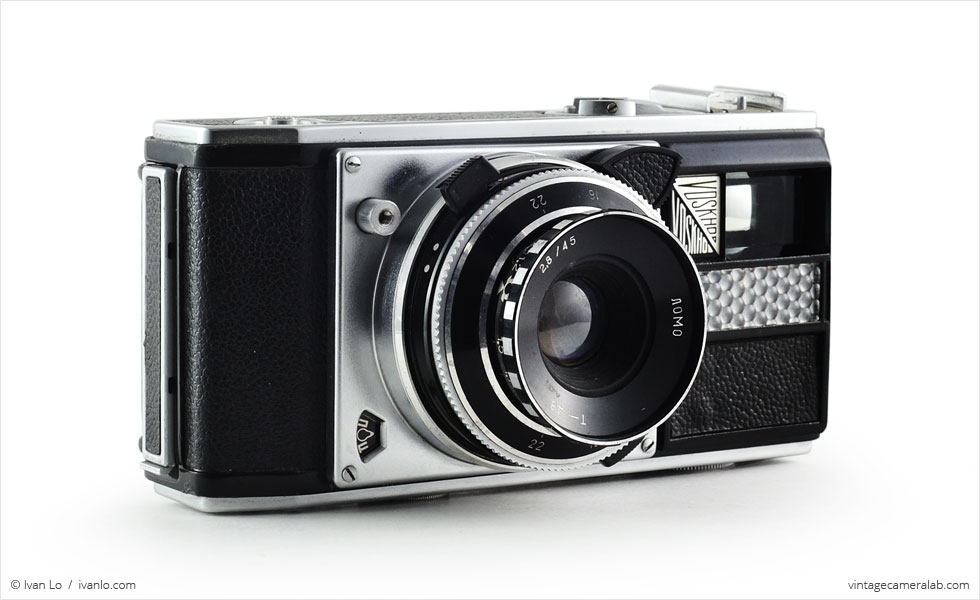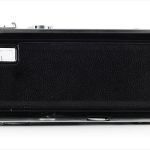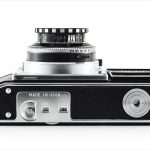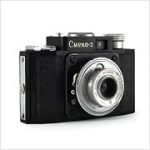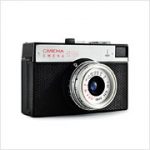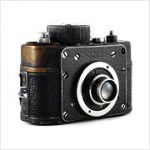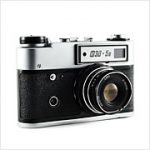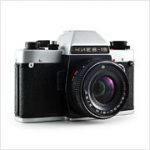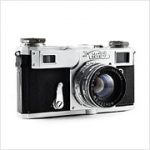GOMZ-LOMO Voskhod Specifications
| Manufacturer: | GOMZ and later |
| LOMO | |
| Origin: | Soviet Union |
| (modern day Russia) | |
| Made in: | Leningrad, USSR |
| (modern day | |
| Saint Petersburg, Russia) | |
| Introduced: | 1964 |
| Type: | Viewfinder |
| Format: | 135 Film |
| Dimensions: | 14.5 x 7.5 x 7.3 cm |
GOMZ-LOMO Voskhod Overview
The GOMZ-LOMO Voskhod is an unconventional 35mm viewfinder camera introduced in 1964 by GOMZ shortly before it reorganized and became the Leningrad Optical-Mechanical Union, better known as LOMO. The Russian term “Voskhod” means “ascent” or “sunrise,” an appropriate moniker since most cameras produced in the Soviet Union at the time were inelegant, utilitarian, and designed for large-scale mass production. With a relatively small production run of just a little over 59,000 units, the Voskhod is far from the average Soviet camera.
Curiously, the Voskhod’s eccentricity is more than skin-deep. For starters, the button that resides in the position where one would typically find the shutter button (on the user’s right-hand side of the top plate) is actually not a button at all but a knob for the frame counter which actually runs backwards like a countdown. The real shutter button is located next to the lens at the 10 o’clock mark, opposite from a flash sync socket at four. A film type indicator resides at eight o’clock (currently showing the marking for tungsten color slide film) with the shark fin-shaped shutter cocking lever at the one o’clock mark.
The outermost ring on the lens barrel controls the aperture while the next ring in adjusts the shutter speed. The innermost ring surrounding the front element of the LOMO T-48 45mm f/2.8 lens controls the focus. The viewfinder window and sensor for the Voskhod’s selenium light meter can be found right next to the lens. Directly above the viewfinder on the top plate is a cold shoe and a film rewind knob. On the bottom of the camera is a small film rewind release button next to a film speed indicator as well as a tripod socket. The film door release button is on the user’s right-hand side panel of the camera with both strap lugs on the opposite side.
True to its offbeat nature, the very existence of the Voskhod is a bit odd. Its exceptionally well built metal construction and its styling leads me to believe that it was not intended for the Soviet masses but the lack of rangefinder and interchangeable lenses don’t make it much of a professional-grade camera, either. Instead, it’s sort of a middle child that may have been made specifically for export, perhaps in an attempt to prove to the rest of the world that the Soviet Union could make something truly interesting.
Whatever it may be, I find it absolutely charming. I love its quirkiness and unapologetic styling and I love the fact that the “Voskhod” badge on the front of the camera can be read in both landscape and portrait orientation. I even love the mishmash of Latin and Cyrillic letters on what is clearly meant to be an export model. In fact, of all the Soviet cameras I own, the Voskhod comes second only to the stylishly minimal Zorki 10 which may possibly be my favorite film camera of all time.
Find your very own GOMZ-LOMO Voskhod on eBay.
McKeown, James M. and Joan C. McKeown’s Price Guide to Antique and Classic Cameras, 2001-2002. (Grantsburg, WI, USA: Centennial Photo Service, 2001), p 254.

